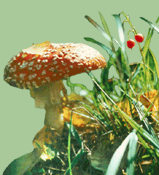Attractive poppies
Ülle Reier features poppies flowers that have given inspiration for numerous legends, songs and poems. The poppy Genus is very diverse and most probably the species have developed in mountainous areas. In Estonia we can find four species of poppies. The author portrays Papaver somniferum the species that is known for its edible seeds, oil, beauty and opium content, and stops on the varieties developed for gardening, as well as on other species of the poppy Genus.
What is the power of poppy all about?
Pharmacist Andres Meos describes the chemical composition and the effect of chemical agents in poppies. He also explains the reasons for opium dependence. Opium, which contains more than 20 alkaloids, is the main agent carrying the power of poppies. The most famous agent is morphine one of the oldest medicaments that is still in use today. The main fears related to the use of poppies are rooted in the characteristics of opium to cause dependence.
Bolls of rattling poppy seeds
Urmas Kokassaar pays tribute to the healthiness of poppy oil as well as the use of seeds as a food addition. He also stresses the fact that the seeds dont contain any narcotic components these are found in the latex of the plants.
A year has not always been a year
Anto Raukas and Enn Kaup draw our attention to the use of calendar in dating old materials. Geologists and archeologists have different dating systems and that can raise problems in understanding each other. The authors explain the essence of radiocarbon dating and give a few exiting examples of datings in Estonia.
The hazardous wastes of oil shale industry can be re-used
Alar Teemusk takes a closer look at the semi-coke and pitch wastes (fuses) generated in oil shale chemistry and at their impact on nature. The main use possibilities of semi-coke are found in energetics, building and agriculture. The pitch wastes have a high fuel value, and can therefore be burned to gain extra energy.
Puhtu-Laelatu Nature Protection Area
Roland Müür invites us to a nature protection area of dignified history the PuhtuLaelatu NPA. The area has been formed in order to maintain natural and semi-natural communities of high species diversity, as well as to protect the migration and nesting areas of waterfowl and forest birds.
Eesti Loodus enquires
Anneli Palo explains what is the Red Data Book of Habitats.
Inna Laanmets introduces the activities of Eco-school and the idea of the Green Flag for schools.
European rarities in Estonia
Riho Männik looks for reasons for the increasing number of Osprey in Estonia. The local population is one of the most vital ones in the world. The breeding success can largely be explained by the cleaner environment and artificial nesting sites.
Essay
Tiit Kändler takes us back to the Ginkgo biloba.
Interview: Nature education back to nature
Helen Alumäe has interviewed Linda Metsaorg, a biology teacher of Tallinn.
On the coast of red trees
Õnne Pärl fell in love with sequoias and visited the majestic trees in North Carolina. Besides seeing and touching the living fossils, she got to see the not-known side of USA idyllic small towns, numerous mammals and inhabited coasts.
Practical tips: how to picture plants
Jaanus Järva gives advice about taking quality photos of plants by sharing his own extensive experiences and illustrating them with fantastic floral beauties.
Stora Enso cares about the forest
Indrek Tust publicizes Stora Enso the reliable forest company orientated towards sustainable forestry.
Caenorhabditis elegans a noble worm
Kaja Reisner introduces the favourite animal of molecular biologists, the Nobel prize winner, nematode sii elegans.
| 

![[IN ENGLISH]](images/gb.gif)





